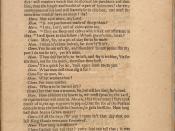Sarah Livingston
Professor Ann Warren
English 215
April 19, 2014
Prescient Imagery in Hamlet's First Soliloquy
In William Shakespeare's Hamlet, the titular character sets the stage for the coming conflicts of the play in his very first soliloquy. He does this by evoking ancient heroes and commoners, growth and rot, and action and inaction. These images directly relate to some of the main themes of the play.
Some of the most explicit imagery in this speech comes from Hamlet's similes. He compares his father and his uncle as "Hyperion to a satyr" (I.ii.144). Hyperion was the great Greek sun god, while in that same mythology the satyr is a chimeric beast- half man and half goat- associated with gluttony and sexual depravity. He also compares himself to Hercules ("Than I to Hercules" (I.ii.157)), suggesting the scale of the epic tragedy that he will take part in without rising to the occasion as assuredly as the Greek heroes he references so often.
A more subtle contrast comes from "'Tis an unweeded garden/That grows to seed. Things rank and gross in nature/Possess it merely." (I.ii.139-141). Here Hamlet evokes a garden, a bastion of life, which, upon closer examination, proves to be foul and rotting. This echoes the larger theme of appearance versus reality in a play where nothing is as it seems. This line's motif of overgrowth also conflicts with the imagery of the lines above it, "How weary, stale, flat, and unprofitable" (I.ii.137), and further below, "As if increase of appetite had grown/By what it fed on" (I.ii.148-149). These two lines evoke barrenness and hunger, respectively, which are greatly at odds with the vivid fulfillment in the aforementioned lines.
One of the most interesting contrasts set up in this speech are that of action versus inaction. The first lines show...

